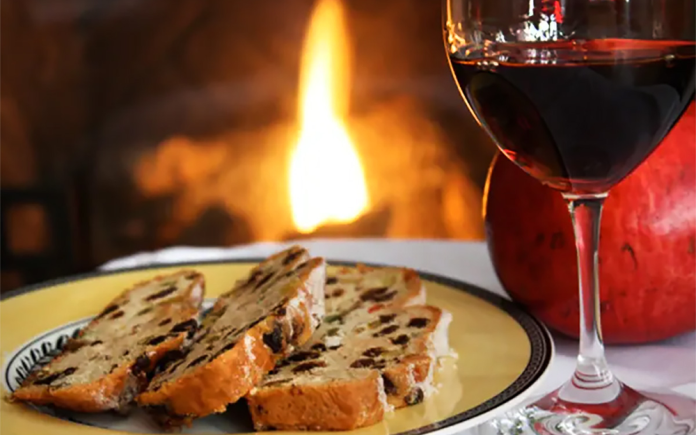
By Rick Riozza
For you folks who know some journalism jargon—or maybe not, you may have heard of the term “puff piece”. An easy definition can call it a journalistic form of puffery: an article or story of exaggerating praise that often ignores or downplays opposing viewpoints or evidence to the contrary—whose purpose (for money or favors) is to praise and flatter.
Believe it or not!—some readers have accused me of actually writing some “puffery” pieces just so I can get a bottle of some $500 wine sent to me by the producer because I tasted it at a wine tasting and fell in love. Who’s got too much time on their hands!
You best believe, if I’m praising a $500 wine, there’s 99.99% chance that I’m speaking the truth!
Anyway—I don’t think there are many around who have to exaggerate praise on the fresh puffy rich but airy gently sweet delicately textured holiday bread known as panettone.
A few decades ago, the Italian treat was an uncommon sight over here. Nowadays your have pyramid stacks of the stuff found at Trader Joes, Whole Foods, or at your neighborhood deli. And most of the stuff is pretty good with coffee in the morning—some a little better than others—it’s a subjective thing for sure. But there is ethereal panettone created in Italy that can be sent right to your door to send you to heaven. We’ll get to that in a bit.
As this column is wont to do, we like to look at the fanfare of how this product came to be. Most origin stories—especially in Europe, are anecdotal and questionably correct. Most of the time, they’re our favorites. How about this one on the “first” panettone:
Its origin goes back to 1495. During the luxurious Christmas banquet given by the Duke of Milan, the desert got burnt. A young cook, called Toni, (not Anthony, mind you, but Toni) came up with a rich brioche bread, filled with raisins and candied fruit. The Duke loved it, and so the tradition of ‘Pane di Toni’ was born.
The internet tells us: “Later, in 1821, Panettone became a symbol of liberty in Italy. Red candied cherries and green-coloured citrus replaced the raisins and fruit, creating the red, white and green Italian flag. A Christmas bread with an exceptional story—and, when made right, equally exceptional taste.”
In Northern Italy a tradition was born by enriching bread with large quantities of butter and egg yolks and usually candied fruit and raisins. It’s definitely not your grandmothers “fruit cake”. Indeed, it is not a cake at all—nor is it made with all those strange and strong British/Scandinavian hard dried fruits.
Reading about the taste and texture of a panettone only gets you so far along; actually tasting one gets to the point really, but Wine Spectator writes: “Many panettones we get these days are sweet and dense and laden with fruit, a little too cakey for traditionalsists. The Italian ideal is far removed from dense fruit cake—rich but airy, gently sweet from honey, with occasional bursts of candied fruit.
“The perfect panettone is neither too sweet nor too savory, it’s delicious any time of day whethered paired with coffee or Vin Santo.” Vin Santo!? What a perfect segue to a panettone wine pairing!
Vin Santo is not the name of that young Latino rapper harping on the radio. Rather, it is one of the world’s premier dessert wines—like in the category of French Sauternes, Hungarian Tokaji, and German Trockenbeerenauslese. Vin Santo is Italian with the most famous production coming from Tuscany.
A figuratively heavenly wine, Vin Santo means, “saint wine,” and there are various anecdotal origin tales tying the wine to the church. Could this wine have been the original wine served during Holy Mass during the reign of the Borges Popes? There are stories out there that tanned the hide of Martin Luther.
Made using traditional methods that see grapes harvested and left out to raisin for three to six months before being vinified into small oak or cedar barrels before yeast is added. The DOC wines must be aged for three years (or longer for the Riserva wines) and are kept in hot attics rather than cool cellars. A slow fermentation follows, then the wine is aged for many years (in many cases more than a decade) in wooden barrels, before being bottled and put on the market.
Until they are opened, it is unsure if they will even turn out well, and it is a bit of a gamble as to the result, but successful Vin Santo wines will be sweet, amber in color, and with notes of nuts, toffee, and raisin. God is good! (if the result is unsuccessful—God is still good—am I to say otherwise!)
Vin Santo’s flavors vary according to the production area, but the wines share some common characteristics: dried fruit, honey, apricot jam, and spices. Of course it pairs perfectly with panettone, but it goes well with dry pastries, leavened cakes, and blue cheeses, and the full-bodied and aged versions pair excellently with chocolate.
One of the best wines out there is the 2014 Avignonesi Vin Santo di Montepulciano Occhio di Pernice at $290. “Rich and concentrated with envelloping aromas of Mediterranean herbs, citron, plums, fruit cake, star anise and a long-lingering, nutty finish.”
A more affordable delicious one is the 2018 Antinori Vinsanto del Chianti Classico at $55. “The nose presents delicate notes of chestnut flour, dried fruit, figs and candied fruits.”
For those of you who wish to treat themselves to the real Italian deal sent to your home straight from the panificio in Italy, go to zingermans.com—$65. for a 26oz loaf; gustiamo.com—$60 for 2.2 pounds; santambroeus.com—$98 for 2 pounds.
Buon appetito & saluti!










































